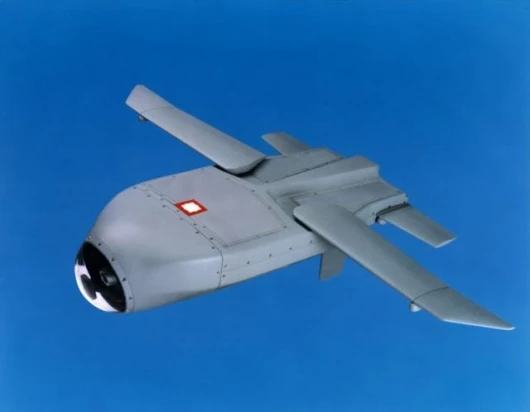November 4, 2005 The cost of armed, autonomous vehicles which can loiter over the battlefield and destroy enemy targets seems to be coming down fairly quickly, if recent flight tests are any indication. The Low-Cost Autonomous Attack System (LOCASS), is an autonomous, wide-area search, miniature munition equipped with a LADAR seeker and was successfully flight-tested at Eglin Air Force Base in Florida, USA on October 21. Each LOCAAS carries a multi-mode explosively formed warhead which can be detonated as a long rod penetrator, an aerostable slug, or as fragments, based upon the hardness of the target. The Lockheed Martin-developed LADAR seeker can identify the target and determine the aim point and warhead mode.
The test LOCAAS was launched from a King Air 200 and flew 45 nautical miles in 15 minutes, powered by its 30-pound thrust class J45G turbo-jet engine, all the while using its laser radar (LADAR) seeker to search for, identify and report on targets in a preplanned mission search area.
While flying the planned mission, the operator-in-the-loop redirected the test vehicle to the location of a moving target elsewhere on the range. Once redirected, the test vehicle altered its predefined flight path to an optimal approach to the moving target as the new primary target of interest.
The Globalstar SATCOM system was used to link the LOCAAS test vehicle and the operator-in-the-loop with a detailed simulation of the Network Centric Collaborative Targeting (NCCT) system. NCCT fused track and identification information from simulated Intelligence, Surveillance, Reconnaissance (ISR) platform sensors to provide the approximate location of the moving, time-sensitive target.
The test vehicle was also linked via data link to the Cooperative Attack Munitions Real-time Assessment (CAMRA) testbed, which simulated three “virtual” munitions cooperatively searching in flight paths adjacent to the test vehicle. Once cued by the operator-in-the-loop, the virtual munitions performed coordinated attack operations in concert with the flight test vehicle using real-time information received across the data link. The link to NCCT allowed the flight test vehicle to act as a non-traditional ISR sensor transmitting detected target vehicle identification, location, time, and weapon status information for use by other systems and operators.
An Air Force flight-rated operator, serving as the operator-in-the-loop, retargeted the LOCAAS flight test vehicle to “attack” the NCCT-tracked moving vehicle. During the test vehicle’s flight, the operator monitored real-time weapon state information, as well as, the near-real time location updates of detected targets provided by NCCT. The operator interface utilized a modified version of the Air Force’s Portable Flight Planning System (PFPS) FalconView map overlay application. The FalconView application was executed on a ruggedized laptop computer and enabled the operator to relay the relevant target track information, as well as break-off and/or abort commands to the LOCAAS flight test vehicle.
The LOCASS’s performance was flawless throughout the test, which including high-G turns, acceleration/decelerations, climbs/dives and maximum flight control deflections to verify vehicle stability.
The Air Force Research Laboratory, Munitions Directorate sponsored the flight test which was the culmination of five successful flights including one with a live warhead.
“This test demonstrated the capability of LOCAAS to integrate automatic combat identification, global data links, operator-in-the-loop involvement, and successful redirect of the weapon,” said Randy Bigum, VP of Strike Weapons at Lockheed Martin.
The LOCAAS can be dispensed from the Air Force SUU-64 tactical munition dispenser, an internal weapons bay carriage, a munition ejector rack, or external pylons. Each can be dispensed also from a Multiple Launch Rocket System (MLRS) rocket or an Army Tactical Missile System (ATACMS) missile.









